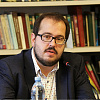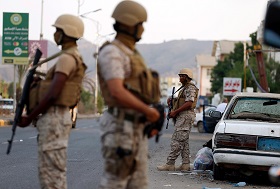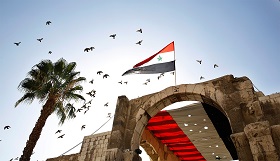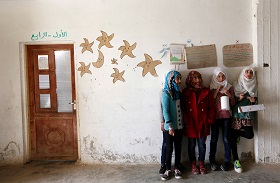On the Matter of the Gulf Cooperation Council’s Regional Security Concept
A member of the Saudi security force stands
guard in front of the logo of the Saudi-led
Islamic Military Counter Terrorism Coalition
(no votes) |
(0 votes) |
Ph.D. in History, Deputy Director for Science of the Institute of Oriental Studies of the RAS, Head of the Center for Arab and Islamic Studies of the Institute of Oriental Studies of the RAS, RIAC Member
In early 2016, the Saudi Gulf Research Center published a report in Arabic subtitled “An Arab Gulf Union is the Future” dedicated to Gulf regional security. Could a different idea be proposed as an alternative to Saudi Arabia’s exclusive security system project?
In early 2016, the Saudi Gulf Research Center published a report in Arabic subtitled “An Arab Gulf Union is the Future” dedicated to Gulf regional security.
The report is important not only because the problem of regional security in the Middle East has recently become a favorite discussion topic, but also because the Jeddah-based Gulf Research Center is chaired by businessman Abdulaziz bin Othman bin Sager. He is considered to be close to the Kingdom of Saudi Arabia’s security establishment, and while his views are not fully same as the royal court’s, they are at least pretty close.
Since the source text has been published in Arabic, we thought it expedient to summarize its key points and offer some comments.
Point No. 1. As a result of events that followed in the wake of the “Arab Spring”, the Arab world’s traditional centers of power – Egypt, Syria and Iraq – have been mired in crises and conflicts. The responsibility for the region’s future and security was laid squarely on the shoulders of the GCC member countries.
The claim that the Gulf’s leadership is not so much a sign of the GCC’s success story as it is a by-product, not even quite desirable at that, of the overall Middle Eastern crisis is at odds with a widespread notion that rich Arab monarchies play a leading role in the region’s transformation. However, it demonstrates quite a realistic and a rather cautious view of the situation in the region – a situation where the GCC countries have to play a role that wasn’t theirs before as they respond to a host of new challenges and threats.
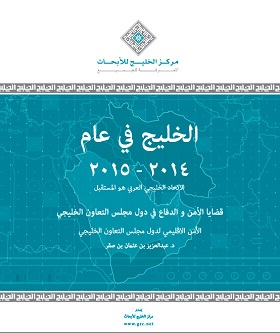
Point No. 2. All elements of regional security in the Middle East are intertwined and interdependent; therefore it’s impossible to maintain the security of the Gulf countries in detachment from the rest of the region.
This case for a pan-regional role of the Gulf monarchies makes one wonder where the boundaries of the Middle East really are.
The notion expressed in Point No. 1 that the Gulf countries are natural regional successors to the leadership of Egypt, Syria and Iraq assumes that those countries are part of a single regional system of relations. At the same time, the report’s ignoring of Turkey’s role, a negative view of Iran and the lack of any mention of the Maghreb set the geographical map of the system it describes as extending from Syria in the north to Oman in the south and from Iraq in the east to Egypt in the west.
As they discuss a unified security system, the report’s authors almost ignore what seem to be the region’s systemic conflicts – those in Syria and the Middle East, – mentioning them only in passing and in connection with completely different threats. This calls for a description of the proposed system as being hierarchical and built not on the basis of balance between its various elements but on the need to ensure the interests and security of the Gulf states, which see the rest of the region as a space of their strategic depth.
Point No. 3. Iran’s open military interference in Arab countries’ affairs is a new phenomenon in the Middle East. It has replaced interventions conducted since 1979 with help from special services and with covert support from certain movements. Iran’s new policy towards Iraq, Syria, Lebanon, Palestine, Yemen and Bahrain is aimed at revising the GCC’s role and changing the regional balance of power.
The claim that the Gulf’s leadership is not so much a sign of the GCC’s success story as it is a by-product, not even quite desirable at that, of the overall Middle Eastern crisis is at odds with a widespread notion that rich Arab monarchies play a leading role in the region’s transformation.
For the report’s authors, the Islamic Republic’s aggressive stance is an existential feature of its political regime, which has been always pursuing the export of revolution.
Not everybody in the Kingdom share such hawkish views. Some experts point out that Iran is capable in principle of abandoning its messianic message and becoming a constructive player, as it once did under Presidents Ali Akbar Hashemi Rafsanjani and Mohammad Khatami.
The claim that Iranian interventionism has an absolute nature is typical. While this argument can possibly be made with regard to Lebanon, Syria or Iraq, the Islamic Republic has never “openly interfered militarily” in Palestine, Yemen or Bahrain. This rhetoric helps the authors not only blow the Iranian threat out of proportion (perhaps because of the Center’s close ties to security services), but also project Saudi Arabia’s national concerns to all countries in the region.
Finally, trumpeting the “Iranian factor” helps sideline the question of domestic threats to the security of the GCC countries. This discourse is turning Iran into an eternal and irreconcilable enemy of the Arab states and the source of all evil – replacing Israel, of which the report makes no mention at all.
Point No. 4. The GCC states must build a strategic deterrence system to guard against Iran’s interference into the Arab countries’ affairs.
The authors believe that pushing back against Iran is the basis for Arab unity, which, in turn, could replace the Islamist alternative that has prevailed for the past half century and become an ideology shaping the region’s identity for years to come.
Remarkably, the events of the “Arab Spring” have demonstrated a trend for a merger of those two traditions that had existed in the Arab world forever.
On the one hand, this heralds a new – communications-driven – basis for pan-Arabism, which seemed to have become a thing of the past. It has transformed it from an ideology of rulers into a tool of protest for the masses.
On the other hand, it is Islamism that, in its different forms, has provided the masses with an ideological and organizational basis for joint actions in the post-revolutionary period, while in most cases Islamists themselves have been integrated into the new elites.
It is the weakening of states that compels non-state actors to feel that they must seek foreign support. It is often the identity of potential “donors” that makes those forces adopt an ideology.
The ideological line of thought followed by the report’s authors seems to fit in well with this convergence paradigm, given the importance of the religious factor for the Gulf monarchies’ political identity. What’s more, this thinking is based on solid historic fundamentals: The first pan-Arab project, within the same borders as today, was proposed by the Sharif of Mecca and Medina during WWI.
Still, there’s one fundamental difference. Both pan-Arabism (in its 100-year-old and five-year-old incarnations) and Islamism (throughout its entire history) have always been ideologies of protest and liberation. Today, the GCC states perceive them through the lens of maintaining the status quo, which strips those ideologies of much of their appeal in the eyes of the masses.
The desire of the GCC states to gain external support will complicate the building of a regional security system in the coming years.
Point No. 5. The Iranian expansionism is feeding “sectarian” movements in the Arab countries, including illegal Shia armed groups.
All stakeholders in the Middle East process trade such accusations, which are largely justified. The problem is that it is the weakening of states that compels non-state actors to feel that they must seek foreign support. It is often the identity of potential “donors” that makes those forces adopt an ideology. Not only that, but close ties between politics and religion in the region often mean that conversion to a given religious current is often a function of potential political support. This concerns both the Salafi movements (such as the Saudi-sponsored an-Nour party in Egypt) and Shia ones (such as the Sabrin organization active in Gaza).
At the same time, besides the Iranian activity in support of Shia movements (or the Saudi one in support of the Salafis), one should take into account the common confessional solidarity and network ties among communities all over the world, and, crucially, the constant presence of domestic (social, economic and institutional) reasons for the proliferation of such groups.
Point No. 6. Barack Obama’s policy is aimed at disengagement from the region, which is translated, first of all, into a reduction of the American military presence in the Gulf area and, secondly, into a weakening of Washington’s support for its allies in the region. There are reasons to hope that this situation will change when a new presidential administration takes over in the US.
The dissatisfaction with American policy and the desire to find external guarantors for the regional sub-system of relations in the Middle East are understandable and consistent with the perception of an imposed nature of the GCC’s leadership. Going forward, this would allow other actors to take the place of the United States if they are ready to arbitrate Middle Eastern disputes – an extremely burdensome task.
The emotionally expressed hope for a change in American policy is also remarkable. It demonstrates not only the emotional side, but also a personified perception of the political process. Granted, the latter is a more or less common feature, yet in this case it shows a substantial dependence of the Gulf countries’ foreign policy on domestic political processes in the United States. Overall, however, the desire of the GCC states to gain external support will complicate the building of a regional security system in the coming years.
Point No. 7. The territorial terrorist organization Islamic State (IS), which has emerged in immediate proximity to the GCC’s borders, constitutes a new threat. It’s not only its quite probable expansion into Jordan and Yemen where IS is already active that is dangerous. What’s really dangerous is that the fight against IS legitimizes the Iranian expansionism in the eyes of the international community and creates a support base for Shia “militias” in various Arab countries.
Iran’s domination of the fight against IS is perceived as a greater threat than IS itself not least because anti-terrorist techniques are obvious and the kingdom is making a good use of them.
The IS threat is not perceived in the paradigm of regional security but rather through the lens of national interests of Saudi Arabia, for which (as for Israel, by the way) Iran is more dangerous. Iran’s domination of the fight against IS is perceived as a greater threat than IS itself not least because anti-terrorist techniques are obvious and the kingdom is making a good use of them.
At the same time, in the reports’ authors’ opinion, a successful fight against IS coupled with the lifting of sanctions and Iran’s integration into the global community are not only fraught with an emergence of an internationally recognized Tehran–Baghdad–Damascus–Beirut Shia axis. Potential implications also include a destabilization in Saudi Arabia’s Eastern Province, Kuwait and Bahrain and a collapse of the monarchies.
Such “export of revolution” would lead to the installation of Shia rule across the entire region.
This could become a threat to national (Arab) statehood on the one hand and to the Sunni majority on the other. Fighting against it only makes support for Sunni movements in those countries natural.
Point No. 8. Yemen is the source of a specific threat to the GCC countries. The crisis in the wake of the “Arab spring” has created conditions in that country for a renewed strengthening of the Houthis, who had been rebeling against the legitimate government there since as far back as 2004. The Houthi movement uses religious discourse to achieve specific political goals that have nothing to do with actual interests of the Yemeni people and that are dictated by Iran.
The perception of Yemen as not just falling within the Gulf states’ sphere of influence, but also as more of an object for their policy than a subject of relations is typical.
The conflict in Yemen is the only regional conflict covered separately in the report. The text, intended for the Arabic reader, is not trying to prove Iranian involvement in Yemen’s affairs or the danger of Houthis coming to power there. It is purely declarative.
Meanwhile, the degree of Iran’s participation in the events in Yemen remains unclear. For example, many Russian experts believe that the Houthi movement is of a national nature that has nothing to do with Iran.
At the same time, the perception of Yemen as not just falling within the Gulf states’ sphere of influence, but also as more of an object for their policy than a subject of relations is typical. It is no coincidence that the report’s authors take it upon themselves to define the real interests of the Yemeni people.
Despite the fact that specific parameters of the new phase of integration remain unclear, it is evident that security should become its main driver.
All the while, the fight against the Houthis is treated as resistance to an anti-system movement whose activity is undermining Yemen’s statehood.
In general, all Iranian activity as the report’s authors see it appears to be not only destructive but also harking back to the past and aimed at the destruction of national statehoods in the region. At the same time, national statehood is viewed through the lens of pan-Arabism. The policy of the Gulf countries, on the other hand, is aimed at cementing institutions and statehoods.
This approach essentially represents an interpretation, custom-tailored for the Saudi interests, of a general trend, shared by the international community, of support for institutions and statehoods in the region – something Russia has been actively calling for. It is worth noting in this regard that several years prior, when support for democratic transformations was a “seasonal fad” in the Middle East, the Gulf’s elites were just as eloquent in their praise for freedom and democracy on the one hand as they were in their denunciation of the totalitarian nature of Iran’s regime on the other.
It can be argued that the tendency to justify their own foreign policy by making references to generally accepted imperatives is yet another evidence of the Gulf states’ aspirations to secure support for their position from outside of the region.
Point No. 9. Security is a common responsibility for all Gulf states, and it requires collective action.
This argument takes us back to the report’s subtitle: “An Arab Gulf Union is the Future”.
The text is mum on any disagreements within the GCC – which is perfectly understandable, since this is not something to talk about, yet it reflects a desire to demonstrate the unity of interests of its member states. The problem is, however, that this logic completely ignores the interests of Gulf states other than Saudi Arabia, which are apparently increasingly diverging. For example, the Sultanate of Oman is not taking part in the Yemen campaign while trying to act as a mediator, the UAE is building close economic ties with Iran, Qatar is from time to time contesting the Saudi leadership in common Arab affairs by actively relying on its own financial and media resources, etc. Bahrain, which perceives Iran as quite a real threat, is perhaps the only Gulf state today whose interests are fully aligned with Saudi Arabia’s. It’s no coincidence that Bahrain has been the most vocal supporter of the idea to intensify integration by turning the Gulf Cooperation Council into a Union.
Despite the fact that specific parameters of the new phase of integration remain unclear, it is evident that security should become its main driver.
The problem is that it could prove insufficient, especially that different countries do not necessarily share the same understanding of their security interests.
Could a different idea be proposed as an alternative to Saudi Arabia’s exclusive security system project?
From Russia’s point of view, the regional security system in the Middle East should be inclusive or (to be realistic) almost inclusive (the matter of how to include Israel in it still remains unclear); therefore, the mutual animosity of Saudi Arabia and Iran must be overcome.
Both sides tend to treat each other’s policy as intrinsically inherent in those countries’ established regimes, so no change of mutual perception appears probable without a transformation or change of the regimes. And since there are no reasons to expect any such transformation in the immediate future, it makes sense to look for other ways for a rapprochement.
One of such ways is to take politics out of this process. Imagine looking for points of positive interaction between the GCC and Iran in the non-political sphere, such as the socio-economic one. Everybody agrees that Syria will need a rebuilding of its economy and a social rehabilitation; what’s more, this need will in no way depend on the nature of a regime that will eventually prevail in that country.
Evidently the GCC countries won’t be ready to help Syria rebuild via Syrian government institutions as long as Bashar Assad stays in power. It’s also evident that Iran, in turn, will avoid working together with any pro-Saudi political forces. Perhaps it would make sense to set up an independent international mechanism involving Saudi Arabia and Iran for rebuilding the Syrian economy both in parallel with its government’s activity and independently of it. This would lay the groundwork for a real rapprochement between the two regional centers of power, and in the future for a revision of their approaches to regional security too.
(no votes) |
(0 votes) |

